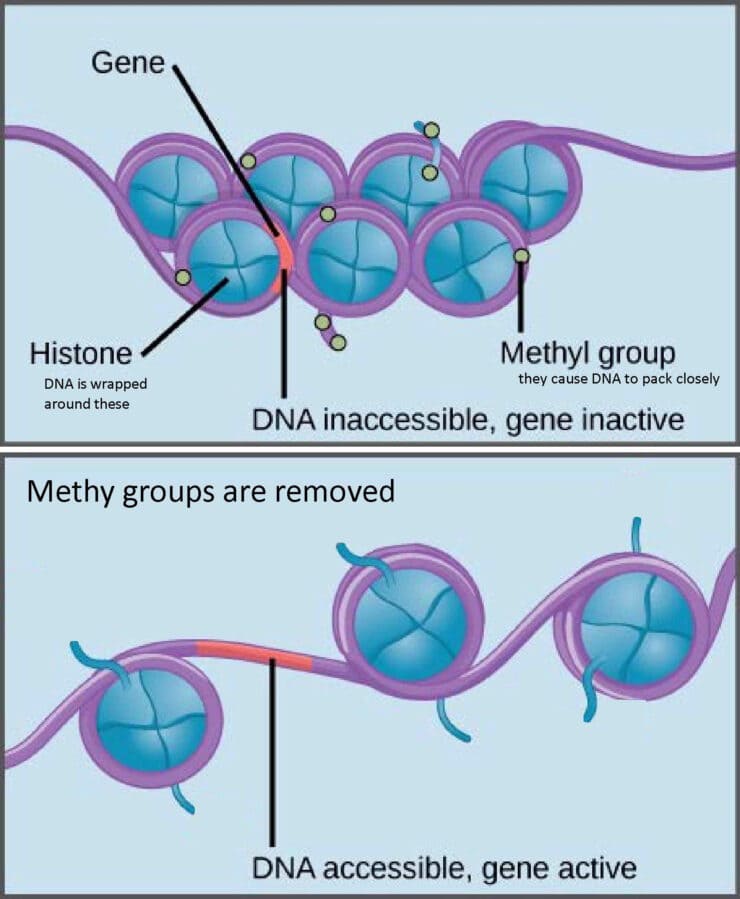Engaging in popular science, you may have come across terms like turning genes on or off. Let’s say spring comes, and trees turn on genes for growth and leaf sprouting, while animals turn on genes to be, well, turned on.
But does it ever cross your mind what it means to turn a gene on or off? Is there a switch? Sort of, but let’s find out.

The short answer: genes are instructions for the body to make proteins. When the protein is being made, the gene is on. Contrary, when that something is not being made, the gene is turned off. Don’t worry if it seems trivial; I will dive deeper below.
What are proteins and how do genes work
So what do genes make? We call products of genes proteins. Are any bells ringing? Well, if they do not, maybe you need to recap what are proteins here, and how genes work here.
What are proteins and how do genes work?
So what do genes make? We call the products of genes proteins. Are any bells ringing? Well, if they’re not, maybe you need to recap what proteins are here, and how genes work here.
In short, though, a protein is a basic building block for life. For example, your muscles consist of proteins, different kinds of them. Muscles are made of proteins, but so is the retina in your eye.
Also, insulin is a protein, and it is notable for its gene turning on and off in response to blood sugar levels. But again, this happens only in pancreatic cells; in all the other cells of your body, the gene to make insulin is turned off. Permanently. So the body must have a switch to do so, right?
Right, but keep in mind that this is a vast oversimplification. I may say “a switch” but it’s more of a switchboard, or even a room full of switchboards. The thing is, a gene can be turned on or off in several manners.
Break the machine to turn off a gene
Though there are several ways to turn off a gene, they all have something in common. Making proteins from DNA is a complicated several-step process, and intentionally breaking something in that process is usually how genes are turned off.
Oversimplified, protein production goes like this:
- Specific proteins attach to a DNA string and slide along it, making an RNA string in the process.
- The RNA is then post-processed and transported outside the nucleus, where it is used as a template for making proteins.
- Proteins also undergo post-production, but the RNA is degraded later.
So, can you spot opportunities to intentionally “break” something? Well, actually in each step your body can.
Methylation to turn a gene off
A common way is to make the DNA denser, thus disallowing proteins to attach to it and read the template. It’s just like if you need to replace a light bulb in your car. The denser stuff is packed under the hood, the harder it is to do so. Sometimes even impossible.
There are several ways to do this with DNA, but a common one is adding methyl (one carbon with three hydrogens) groups to either proteins that “hold” DNA or the DNA itself. This is called methylation and it makes the DNA denser. Removing these groups makes the DNA looser.

The amount of methyl groups also determines how dense the DNA will be.
This allows for fine-tuning: beyond just being on or off, the gene may be on to a degree. Similarly, a valve can regulate water flow besides only two states of water running and water not running.
Other ways to turn off a gene
But let’s say the machinery can access the DNA. Well, the machinery itself must exist. And that means all the parts that it consists of MUST exist and work properly. Here are other ways to disallow that:
- The machinery that reads DNA (called polymerase, just so you know) is large and complex, but it also relies on smaller molecules, called transcription factors, to function. The machinery attaches to the DNA string and is ready to go, but it must wait for transcription factors to attach as well. Thus, the body can refrain from making these transcription factors and it will effectively turn off a gene.
- When the RNA is made, it is passed on to ribosomes, which attach to it and make proteins. An opportunity to break something again. A special type of protein, called operons, can attach to the RNA and block the ribosome from sliding along it.
- Another common on-and-off switch are specific RNA strings that can attach to other proteins making RNAs and either make them inaccessible or quite the opposite, accessible to ribosomes.
- Okay, one more. RNA is usually reused to make the same protein again. At the same time, the body can speed up the degradation of the RNA, thus, while not turning off, slowing down protein production.
These are just a few examples, listing the most common techniques of how the body can turn some genes off. These processes are complicated and we are just beginning to understand them.
As previously mentioned, a common theme in any method used to turn off a gene involves deliberately disrupting a complex process that converts a gene into its end product protein.